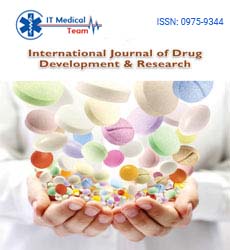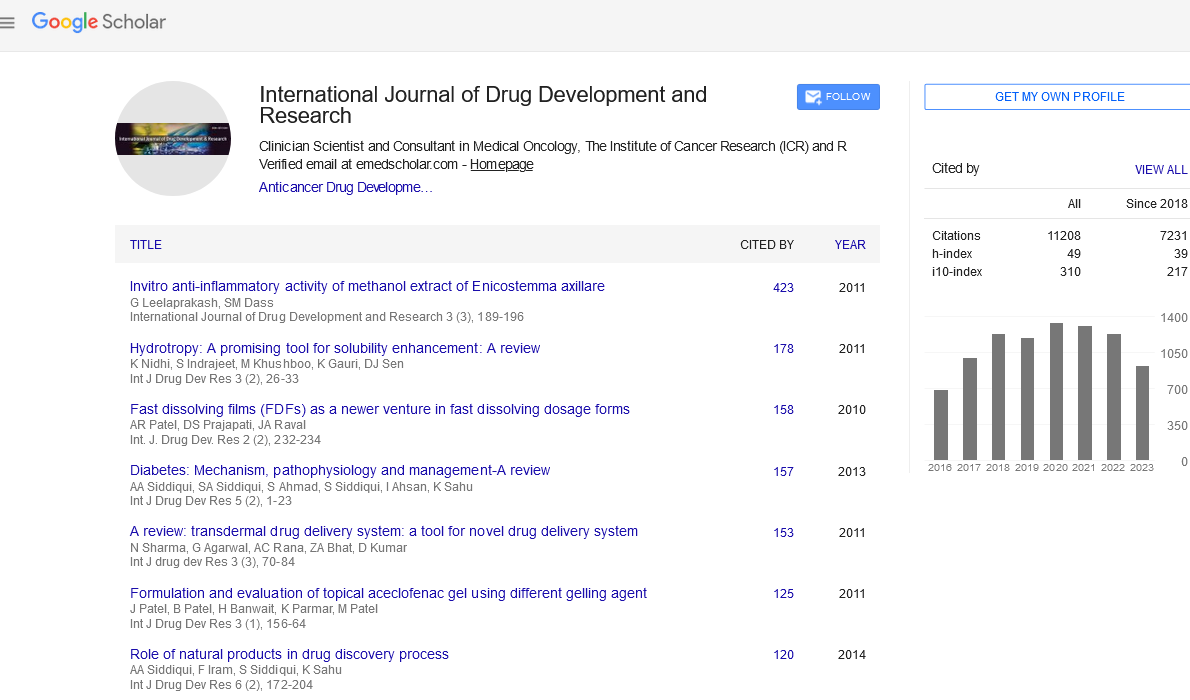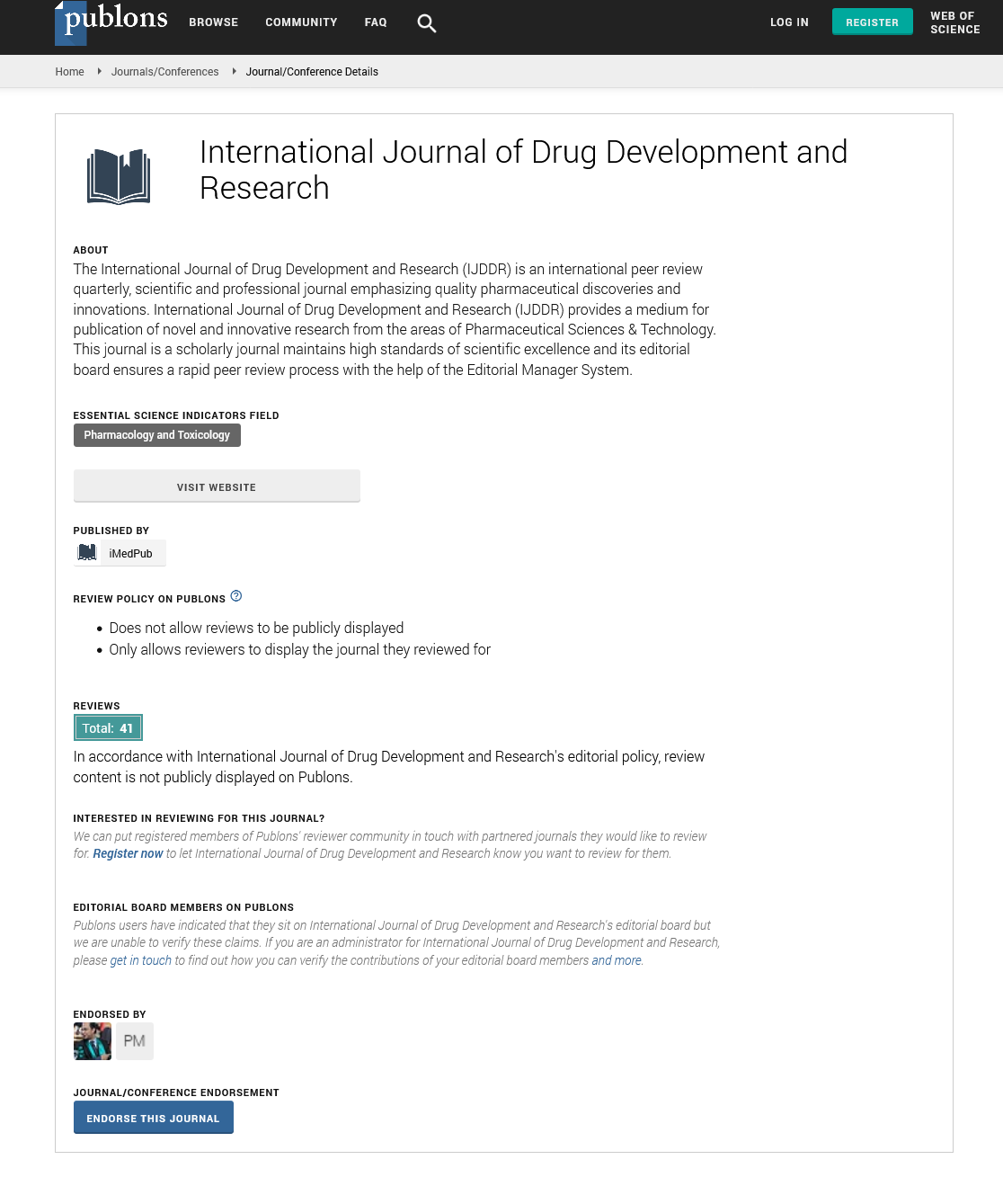Editorial - (2022) Volume 14, Issue 6
Researching the Relationships Between Adverse Drug Reactions and Therapeutic Uses, Creating and Functionalizing Nanomaterials for Therapeutic Drug Delivery, and Developing Therapeutic Cancer Vaccines.
Hari Krishna Sajja*
Department of Surgery, Emory University School of Medicine, Atlanta, GA 30322, United States
*Correspondence:
Hari Krishna Sajja, Department of Surgery, Emory University School of Medicine, Atlanta, GA 30322,
United States,
Email:
Received: 03-Jun-2022, Manuscript No. IJDDR-22-12810;
Editor assigned: 06-Jun-2022, Pre QC No. IJDDR-22-12810;
Reviewed: 25-Jun-2022, QC No. IJDDR-22-12810;
Revised: 30-Jun-2022, Manuscript No. IJDDR-22-12810;
Published:
08-Jul-2022, DOI: 10.36648/1791-809X.22.16.961
Editorial
Therapeutic Drug Delivery
An oral and intravenous form of the triazole antifungal voriconazole
is available for the treatment of fungal infectious diseases.
Aspergillus, Candida, Cryptococcus, Fusarium, and Scedosporium
are only a few of the clinically significant pathogens that it has
substantial efficacy against. VRCZ has a highly variable intra- and
inter-individual pharmacokinetic profile.[1] Numerous variables,
including sex, age, race, genotypic variance, liver disease, and
the presence of food, contribute to this heterogeneity. Drug
interactions with CYP450 inducers and inhibitors are another
significant factor affecting the pharmacokinetic profile of VRCZ.
Drug discovery is a time-consuming and costly procedure. To
bring a single medicine to market, it typically takes at least 10-15
years and between USD 500 million and USD 2 billion. The number
of novel therapeutic chemical and biological entities approved by
the US Food and Drug Administration (US FDA) has been falling
since the late 1990s, despite a large rise in recent years in drug
development research. The two main causes of pharmaceuticals
failing clinical trials are as follows: (1) Ineffectiveness; (2) negative
side effects Furthermore, each of these two causes’ accounts for
about 30% of clinical trial failures.[2] The creation of tools that
can reliably forecast pharmacological therapeutic indications
and adverse effects is therefore extremely desirable. Some of
the biggest problems in current medicine may be resolved by
nanomaterial. They differ from their macro scale counterparts
at the Nano scale due to their special optical, magnetic, and
chemical properties. Successful use of Nanomaterials can
transform imaging, diagnostics, and treatments in a variety of
biomedical applications.[3] Self-assembled amphiphilic polymeric
nanoparticles have been used to transport chemotherapy
medicines that aren't very soluble. It has been demonstrated
that adding anticancer chemotherapeutic medicines increases
the circulation time, tumor localization, and therapeutic
potential of self-assembled polymeric nanoparticles.[4] An
introduction to organic nanotechnologies for medication delivery
is provided in this book chapter. We'll talk about promising
developments in the realm of Nano medicine and offer a look
ahead. The use of therapeutic cancer vaccines in the treatment
of various cancer kinds and stages is a possibility. The possibility
for developing vaccinations to target cancer cell "stemness,"
the epithelial-to-mesenchymal transition phenotype, and drugresistant
populations is discussed along with the vast range
of vaccine platforms and vaccine targets. [5]Preclinical and
recent clinical studies are now revealing how vaccines can best
be used in combination with other immune-based therapies
like checkpoint inhibitors, and so-called nonimmune-based
therapeutics, radiation, hormonal therapy, and some small
molecule targeted therapies; it is now being revealed that many
of these conventional therapies can lyse tumour cells in a way
that further potentiates the host immune response, alter the
phenotype of nonlysed tumour cells to become more receptive
to the immune. [6] Due to their benefits like thermodynamic
stability, optical clarity, ease of synthesis, and special capacity
to act as super-solvents for solubilizing both hydrophobic and
hydrophilic solutes, nanoemulsions have attracted significant
attention in both research and treatments.[7] Nanoemulsions
are widely used in both the detection and treatment of diseases as a result of the qualities stated above. Because of this, the
current review's goal is to summarize these applications of
this unique drug delivery system by talking about the patents
that cover different uses of this system.[8] Less than twenty
drug compounds have been approved by regulatory bodies
for transdermal administration, which is a comparatively small
amount. The advantages provided by the transdermal method
could be applied to numerous different medicines. The stratum
corneum's amazing effectiveness as a diffusional barrier and its
remarkable capacity to impede molecular transport explain why
they haven't done so yet. [9] The only treatments that can be
passively diffused over undamaged skin at pharmacologically
relevant rates are those that are exceedingly powerful and have
the appropriate physicochemical features. Due to this, a number
of delivery methods have been created that may be employed
to increase the number of medicinal agents that can be supplied
transdermally while maintaining the necessary delivery kinetics.
[10] There are basically two methods: I boost the driving force
to speed up transport (i.e., act on the molecule) or (ii) alter the
characteristics of the microenvironment where diffusion must
take place (i.e., act on the stratum corneum). The difficulty with
the latter strategy is compromising the barrier in a way that is
reversible, reasonably painless, and useful for chronic diseases
while posing the least amount of infection risk. With a focus on
technologies that have either resulted in marketed products
or have at least reached the clinical development stage, we
review some of the physical techniques that have been used to
temporarily disrupt the skin barrier or to provide extra driving
forces to facilitate molecular transport.
Acknowledgement
The author would like to acknowledge his Department of
Pharmacogenomics, Center for Applied Medical Research from
the University of Navarra for their support during this work.
Conflict of Interest
The author has no known conflicts of interested associated with
this paper.
References
- Caruthers SD, Wickline SA, Lanza GM (2007) Nanotechnological applications in medicine.Curr Opin Biotechnol18: 26–30.
Indexed at, Google Scholar, Crossref
- Portney NG, Ozkan M (2006) Nano-oncology: drug delivery, imaging, and sensing.Anal Bioanal Chem. 384: 620–630.
Indexed at, Google Scholar, Crossref
- Alivisatos P (2004) The use of nanocrystals in biological detection.Nat Biotechnol 22: 47–52.
Indexed at, Google Scholar
- Sinha R, Kim GJ, Nie S, Shin DM (2006) Nanotechnology in cancer therapeutics: bioconjugated nanoparticles for drug delivery.Mol Cancer Ther5: 1909–1917.
Indexed at, Google Scholar, Crossref
- Yezhelyev MV, Gao X, Xing Y, Al-Hajj A, Nie S (2006) Emerging use of nanoparticles in diagnosis and treatment of breast cancer.Lancet Oncol 7: 657–667.
Indexed at, Google Scholar, Crossref
- Harisinghani MG, Barentsz J, Hahn PF, Deserno WM, Tabatabaei S, et al. (2003) Noninvasive detection of clinically occult lymph-node metastases in prostate cancer.N Engl J Med 348: 2491–2499.
Indexed at, Google Scholar, Crossref
- Hood JD, Bednarski M, Frausto R, Guccione S, Reisfeld RA, et al. (2002) Tumor regression by targeted gene delivery to the neovasculature.Science. 296: 2404–2407.
Indexed at, Google Scholar, Crossref
- Cunin F, Schmedake TA, Link JR, Li YY, Koh J, et al. (2002) Biomolecular screening with encoded porous-silicon photonic crystals.Nat Mater1: 39–41.
Indexed at, Google Scholar, Crossref
- Cao YC, Jin R, Mirkin CA (2002) Nanoparticles with Raman spectroscopic fingerprints for DNA and RNA detection.Science. 297: 1536–1540.
Indexed at, Google Scholar, Crossref
- Stern ST, McNeil SE (2008) Nanotechnology Safety Concerns Revisited.Toxicol Sci101: 4–21.
Indexed at, Google Scholar, Crossref
Citation: Sajja HK (2021) Researching
the Relationships Between Adverse Drug
Reactions and Therapeutic Uses, Creating
and Functionalizing Nanomaterials for
Therapeutic Drug Delivery, and Developing
Therapeutic Cancer Vaccines. Int J Drug Dev
Res J , Vol.14 No. 6: 961.






